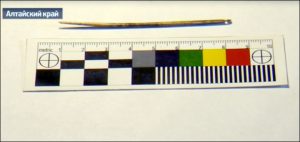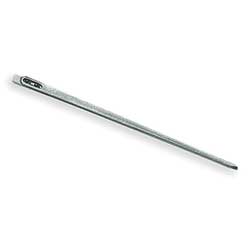I thought I’d step back from dire politics, horrendous wars, and unimaginable natural disasters for a look at an amazing artifact just announced to the world.
This bone needle.

Of probable Denisovan origin, it dates to around 50,000 years old, and was found at a very information-rich cave site in Siberia.
What’s so cool about this piece?
It’s a sign and symbol of human* ingenuity.
It’s a tool of creation.
A needle is a long, tapered sliver of something relatively hard, with a point at one end and a hole or a single or double split prong at the other. The point goes through leather, basketry coils, or woven or knitted cloth…or even flesh, if you’re stitching a wound. The hole carries a doubled thread or cord; the split prongs do the same thing for a single cord, helped along by tension and/or some thin cord wrapping.
Needles help human beings make things and alter their environment. These are sophisticated tools requiring good spacial skills and predictive reasoning to even imagine.
Some of the easiest (and probably earliest) needles were porcupine quills, which have a wicked natural point on them and can carry a thread of plant fiber or animal sinew. This Etsy shop has pre-drilled quills, in case anyone wants to sew old-school.
We still have the basic form today, in steel or bronze two-prong needles for leather lacing. Here’s an example from Tandy Leather, Inc. The leather gets pushed between the two prongs, and possibly secured with some thin thread in those two holes you see inside the top prong.
The leather gets pushed between the two prongs, and possibly secured with some thin thread in those two holes you see inside the top prong.
Split-backed or two-prong needles in bone, ivory, stone, or hardened wood are very prone to break or give way, usually just when you are dragging the needle through a tough piece of leather that you forgot to pre-punch with a slightly larger hole. Or you made the hole too small. Or any number of reasons that don’t salve your frustration factor.
The smart thing (other than being very finicky about pre-punched holes!) is to forget about the prongs, and put a hole in the back end of the needle. You still have to be careful about breaking that fragile end, but it makes sewing so much easier.
I made a fossilized mammoth-ivory needle in a paleontology class years ago. It took a couple of hours, even with steel tools and modern sandpaper.
This is my first 2.5″ long needle. I’m amazed I still have it after all these years.
It earned about a B- if I recall. The hole is drilled off-center, with a risk of snapping on that side. The back grooves meant to carry the thread below the level of the needle (less snagging!) are also off-center. I made another, slightly larger one in that class, and it turned out so well the teacher encouraged me to ornament it below the hole with an inlaid turquoise disk. That needle sold for $30 to an SCA historical re-enactor a few years later. (I’m looking at this one, plotting to chop it down and re-drill the back. Hey, another metaphor for trunked works and revision!)
For a paleolithic artisan, a holed needle would have been an even bigger investment in time and material…and a valuable trade good, once finished.
The really cool thing about this Siberian needle?
*It wasn’t technically made by humans, but by our long-extinct older cousins. Denisovans are a recently-discovered hominid species or subspecies who existed well before modern-type Homo Sapiens, and appeared to range around what is now northeast Asia and Siberia. At least 125,000 years back, maybe more. They were an arty bunch, too, showing evidence of some startlingly modern-looking and well-designed jewelry.
So bully for proto-humanity, making needles in southern Siberia that long ago!